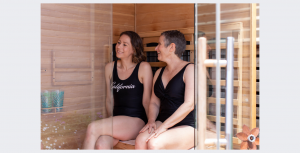
What are the Health Benefits of Saunas for the skin?
Infrared sauna benefits for the skin include; skin growth and regeneration of skin cells, improving circulation which carries oxygen and nutrients underneath the skin, detoxification for cellulite and scar appearances, as well as stimulating the temperature of the skin to release pores and remove dead cells for acne benefits. Other benefits include:
- Benefits for cardiovascular health
- Benefits for muscle soreness
- Benefits for chronic pain
- Benefits for blood pressure
Maybe I will discuss these in detail at another time…..
How often should you Sauna for skin benefits?
A minimum of two times a week is recommended to see the results of skin appearance from an infrared sauna. Saunas have many health benefits and for all benefits – the more frequent sauna use provides better results – more so than the amount of time spent inside the sauna. Therefore, how often you should sauna is more important than how long you should spend in a sauna or how hot a sauna should be.
Are Saunas healthy for the skin?
Yes, sauna bathing is healthy for your skin. A study titled “Effect of regular sauna on epidermal barrier function and stratum corneum water-holding capacity in vivo in humans” examined 41 healthy volunteers aged between 20-49 years, who were divided into two groups – a group with regular sauna exposure and a control group with no regular sauna exposure. The effect of regular sauna bathing was assessed using non-invasive instruments that measure skin physiology, including stratum corneum water-holding capacity, skin redness, transepidermal water loss, and surface skin pH.
These are all important factors that contribute to skin health and can affect how young or old the skin appears. Here’s why:
- The stratum corneum is the outermost layer of the skin and plays a crucial role in maintaining the skin’s moisture levels. A high water-holding capacity of the stratum corneum means that the skin is better able to retain moisture, which can lead to a smoother, more supple appearance and a reduction in the appearance of fine lines and wrinkles.
- Skin redness can be a sign of inflammation or irritation, which can contribute to premature aging of the skin. By measuring skin redness, researchers can assess the impact of various factors, such as environmental stressors or skincare products, on the skin’s overall health and appearance.
- Transepidermal water loss (TEWL) is a measure of how much moisture is lost through the skin’s surface. High levels of TEWL can indicate that the skin’s barrier function is compromised, which can lead to dryness, irritation, and premature aging.
- Epidermal blood perfusion refers to the flow of blood through the tiny blood vessels in the skin’s epidermis. This can impact the skin’s overall health and appearance, as blood carries nutrients and oxygen that are essential for healthy skin cell function.
- Surface skin pH is a measure of the acidity or alkalinity of the skin’s surface. The skin’s pH plays an important role in maintaining the skin’s natural barrier function and protecting it from external stressors. An imbalance in surface pH can lead to dryness, irritation, and premature aging.
The results of the study showed that regular sauna exposure had a positive effect on skin physiology after exposure to two, 15-minute sauna sessions. Specifically, the volunteers with regular sauna exposure had positive effects on the cardiovascular system, and also had a decreased amount of oil on the skin’s surface. This may be helpful for people with oily or acne-prone skin. The study also suggests that regular sauna use can protect the skin by maintaining its pH level and ability to retain moisture.
Are Saunas good for face skin?
Yes, time spent inside a sauna room is good for the face skin, as mentioned earlier in the study. This extends to facial skin, which benefits from the production of enzymes that provide it with that aforementioned “fountain of youth” of subdermal chemistry and stimulates skin cell regeneration.
Do Saunas tighten skin?
Yes, research suggests that spending time soaking up far-infrared wavelengths can increase collagen and skin elastin production in skin cells and potentially lead to a more youthful, radiant complexion. Collagen and elastin are two proteins that play a crucial role in maintaining the structure and elasticity of the skin. Collagen supports the skin and helps keep it firm, while elastin allows the skin to stretch and bounce back to its original shape. One study focused on the changes caused by infrared radiation on the skin in collagen and elastin production of skin cells and its effects on the appearance of facial skin lesions. Results showed more collagen and elastin were found in the skin cells following infrared radiation exposure, with the increase being directly proportional to the duration of exposure. Meaning, the longer they were exposed to infrared wavelengths, the more collagen and elastin were produced. After six months of treatment, patients reported significant improvements in skin texture and roughness and fair improvements in skin colour tone, although no significant improvement was seen in hyperpigmented lesions.
The aim of the study was to help skin that has been damaged by the sun, and the authors suggest infrared radiation might work well. However, the study used a laser of far-infrared light but not a far-infrared sauna. Both the laser used in the study and far-infrared saunas produce the same wavelength of far-infrared light.
Is a Sauna good for acne?
Yes, saunas, particularly infrared saunas, are good for acne as they help to clear skin pores and prevent blockage of the sebaceous gland responsible for creating sebum – the skin’s natural oil. These benefits also contribute to healthier hair follicles and potential sauna hair health benefits. Infrared saunas use targeted infrared light that penetrates beneath the skin and directly targets the sebaceous gland while clearing pores through the body’s reaction to the heat. A research article showed that infrared light exposure as a treatment for acne resulted in a significant reduction of inflammatory lesions with no unusual treatment-related adverse effects observed. Another reason why saunas can be an effective tool for acne is the removal of dead cells.
What is the role of dead skin cells in acne?
Dead skin cells have a significant impact on skin appearance because they can clog pores and cause blemishes such as acne. They additionally make the skin look dull by preventing light from reflecting off the surface of the skin. Sweating reduces the build-up of dead cells on the skin and is another reason saunas are good for your skin.
What type of Sauna is best for Skin Benefits?
Infrared saunas are considered the best type of sauna for skin benefits, according to clinical studies. Infrared saunas are better than traditional saunas and a steam room for treating acne because they target problematic sebaceous glands and promote the clearing of the glands, as well as the promotion of healthy skin cells. In addition, infrared saunas can aid in detoxifying the lymphatic system, eliminating certain heavy metals and toxins from the body. Traditional Finnish saunas use dry heat, while the steam room uses moist heat. Regardless of the type of sauna, it is crucial to drink plenty of water before and after use to reduce the risk of dehydration from heavy sweating.
Improved blood flow: The same skin benefit a steam room, infrared and traditional sauna have in common
Steam rooms, traditional saunas and infrared saunas can all provide an increase in blood circulation underneath the skin’s surface for activating sebaceous glands. As the heat rises, so too does the body temperature which causes the heart rate or pulse rate to increase and more oxygenated blood to rise to the surface of the skin. This is what causes the blushing or redness when using a steam room or sauna., regardless of wet heat or dry heat.
Does Sauna age your skin?
No sauna has not been shown to age the skin. Sauna bathing has been shown to have a positive effect on the skin, and contrary to popular belief, it does not dry out the skin. In fact, many peer-reviewed studies suggest it may even benefit patients with psoriasis, a chronic skin condition characterised by dry, itchy, and scaly patches.
Can Sauna cause skin problems?
Spending time in a sauna can cause skin problems and symptoms for people suffering from skin conditions. It may increase itching in patients with atopic dermatitis, a common form of eczema that causes inflamed, itchy skin.
Should you moisturise after a sauna?
Yes, you can moisturise after sauna bathing to help retain moisture and healthy skin oils after your session. This may be different depending on the type of sauna used, for example, infrared saunas are different from traditional saunas and the steam room because they don’t expose the skin to high temperatures and promote the production of healthy enzymes to keep the skin moist after use. This may vary from person to person, and we encourage users to choose organic and non-toxic products if applied before or after sauna use.
Does the Sauna make your skin glow?
Yes, the sauna makes your skin glow because it helps maintain the skin’s pH levels as explained early. This allows the skin to retain more moisture and allows light to reflect off the natural oils produced, resulting in a skin glow.
In conclusion, incorporating regular sauna use into a self-care routine can provide numerous benefits for overall health and wellness, including healthier, more youthful-looking skin. Sauna sessions can promote collagen production, improve blood flow, and reduce stress, leading to radiant, glowing skin. And if skin benefits are your top priority, infrared saunas are your best bet.
Adapted from an article by Clearlight Saunas

